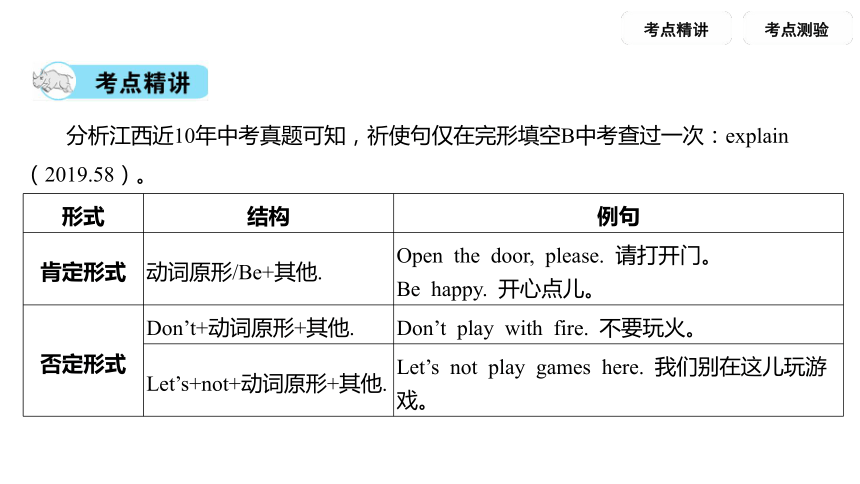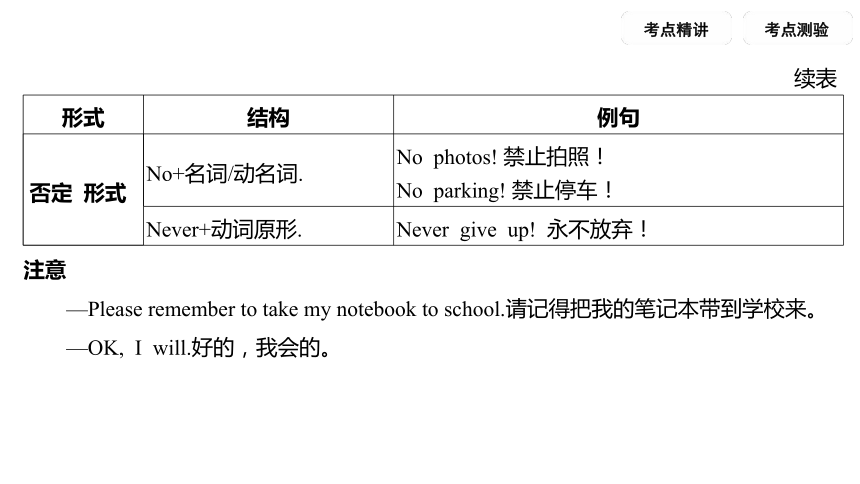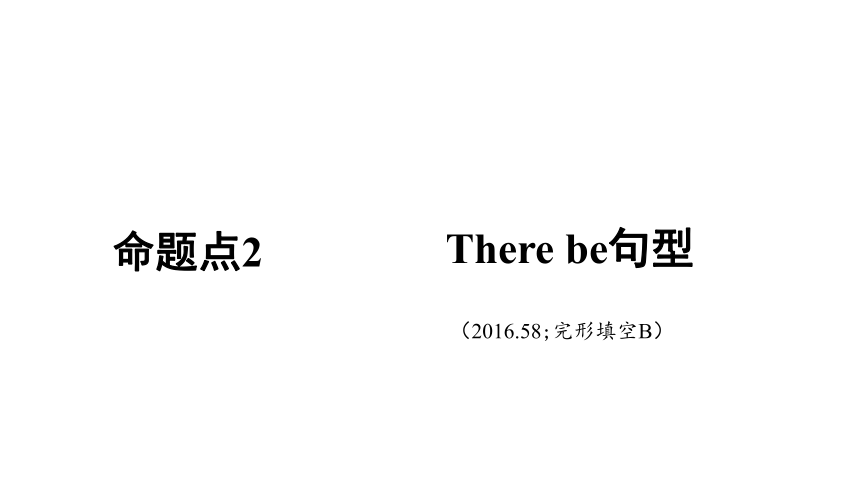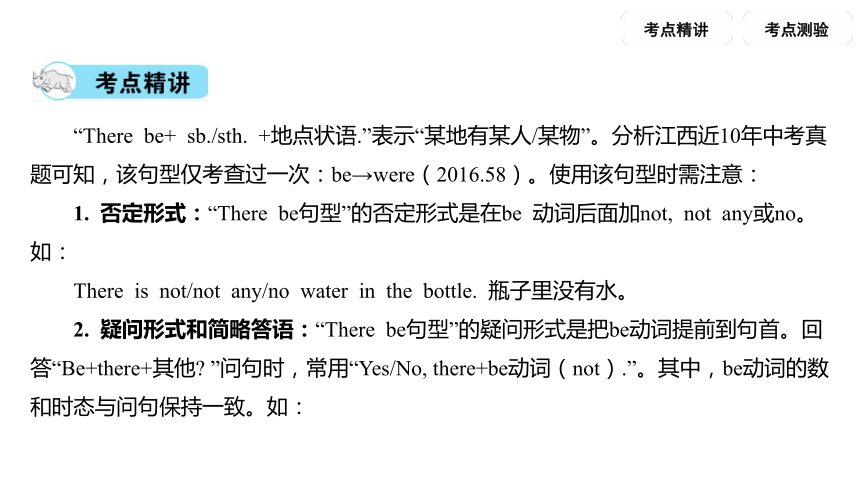2021-2022江西中考英语复习课件 10.专题九 简单句(共26张PPT)
文档属性
| 名称 | 2021-2022江西中考英语复习课件 10.专题九 简单句(共26张PPT) |  | |
| 格式 | pptx | ||
| 文件大小 | 219.6KB | ||
| 资源类型 | 教案 | ||
| 版本资源 | 通用版 | ||
| 科目 | 英语 | ||
| 更新时间 | 2022-04-27 13:27:55 | ||
图片预览









文档简介
(共26张PPT)
专题九 简单句
命题点1 祈使句
命题点2 There be句型
命题点3 疑问句
命题点4 感叹句
命题点1
祈使句
(2019.58;完形填空B)
分析江西近10年中考真题可知,祈使句仅在完形填空B中考查过一次:explain(2019.58)。
形式 结构 例句
肯定形式 动词原形/Be+其他. Open the door, please. 请打开门。
Be happy. 开心点儿。
否定形式 Don’t+动词原形+其他. Don’t play with fire. 不要玩火。
Let’s+not+动词原形+其他. Let’s not play games here. 我们别在这儿玩游戏。
形式 结构 例句
否定 形式 No+名词/动名词. No photos! 禁止拍照!
No parking! 禁止停车!
Never+动词原形. Never give up! 永不放弃!
续表
注意
—Please remember to take my notebook to school.请记得把我的笔记本带到学校来。
—OK, I will.好的,我会的。
( )1.—Please ______ your phone call here. A class of students are taking their examination.
—I am sorry that I didn’t notice it.
A. make B. don’t make C. making D. not to make
B
( )2.—As we all know, life is short but amazing.
—______ it, and you will find the pleasure of life.
A. Enjoy B. To enjoy C. Enjoying D. Enjoyed
A
( )3.—______ parking here, please.
—Sorry. I will move the car away right now.
A. No B. Don’t C. Not D. Not to
A
命题点2
There be句型
(2016.58;完形填空B)
“There be+ sb./sth. +地点状语.”表示“某地有某人/某物”。分析江西近10年中考真题可知,该句型仅考查过一次:be→were(2016.58)。使用该句型时需注意:
1. 否定形式:“There be句型”的否定形式是在be 动词后面加not, not any或no。如:
There is not/not any/no water in the bottle. 瓶子里没有水。
2. 疑问形式和简略答语:“There be句型”的疑问形式是把be动词提前到句首。回答“Be+there+其他 ”问句时,常用“Yes/No, there+be动词(not).”。其中,be动词的数和时态与问句保持一致。如:
—Was there a park in your city 20 years ago 你们城市20年前有公园吗?
—Yes, there was. 有。(肯定回答)
—No, there wasn’t. 没有。(否定回答)
3. 时态:“There be句型”可用于不同的时态,而且可以和助动词或情态动词连用。如:
There will be/There is going to be a new film on Monday. 星期一将有一场新电影上映。
There must be a mistake somewhere. 肯定有个地方出错了。
时态 There be 句型结构
一般现在时 There is/are…
一般过去时 There was/were…
一般将来时 There will be…/There is/are going to be…
现在完成时 There has/have been…
拓展:There be句型常见的时态及其结构
4. be动词的单复数:be动词的单复数必须和其后紧跟的名词的数保持一致。当be动词后仅有一个单数名词或者一个不可数名词时,be动词用单数;当be动词后仅有一个复数名词时,be动词用复数;当be动词后有两个或两个以上的并列名词时,be动词和邻近名词的数保持一致,即遵循“就近原则”。如:
5. There+be+sb. doing sth.+地点状语/时间状语,表示“某地/某时有某人正在做某事”。如:
There is a baby sleeping in the room. 房间里有个婴儿正在睡觉。
注意
“There be句型”强调某地有某物,不表示所属关系;have表示所属关系,强调某人或某地拥有某物。“There be句型”不能和“have(有)”同时使用。如:
There is going to have a basketball game this afternoon.(×)
There is going to be a basketball game this afternoon.(√)
( )4.There ______ a music festival in our school last Sunday.
A. is B. was C. are D. were
B
( )5.—Is there any food in the fridge
—______. I bought a lot in the supermarket yesterday.
A. Yes, there is B. Yes, there are C. No, there isn’t D. No, there aren’t
A
( )6.—There ______ a clean river and some beautiful mountains in my hometown.
—Yes, lots of people come to spend the weekends.
A. is B. are C. has D. have
A
( )7.There ______ a concert in Suzhou next month. I’ll go and watch it.
A. will have B. is going to be C. is going to have D. are going to be
B
命题点3
疑问句
(近10年未考查)
一般疑问句
用yes或no来回答的疑问句叫作一般疑问句。
形式 答语
Be+主语+其他 Yes/No(, 主语+be/be+not).
情态动词+主语+动词原形+其他 Yes/No(, 主语+情态动词/情态动词+not).
助动词(Do/Does/Did/Have/Has/Had/Will)+主语+动词原形/过去分词+其他 Yes/No(, 主语+助动词/助动词+not).
疑问词(组) 含义及用法 常用答语
what 什么,询问物品、职业或身份。 根据实际情况作答。
who 谁,询问人物。 which 哪一个,询问特定范围内的人或物。 whose 谁的,询问所属。 when 什么时候,询问时间。 why 为什么,询问原因。 where 哪里,询问地点或位置。 how 如何,询问方式。 特殊疑问句
用特殊疑问词引导的疑问句叫作特殊疑问句,特殊疑问句不能用yes或no来回答。
疑问词(组) 含义及用法 常用答语
how much 多少,询问不可数名词的数量。 代词/数词+单位名词+of+不可数名词.
多少钱,询问价格。 根据实际情况作答。
how many 多少,询问可数名词的数量。 数词(+单位名词+of+可数名词复数).
how often 多久一次,询问频率。 频度副词/次数+a(n)/one+表示时间的名词.
how long 多长,询问物体的长度。 数词+单位名词+long.
多长时间,询问时间的长短。 For+时间段.
how far 多远,询问距离。 ①It’s+一段时间’s…;②距离
how soon 多久以后。 In+时间段.
续表
选择疑问句
提出两种或两种以上的情况,要求对方选择一种情况作答的问句叫作选择疑问句,列出的情况常用or连接。
形式 答语
一般疑问句+or+选择项? 选择疑问句不用yes或no回答, 可用完整的陈述句或其中一个选择项作答, 也可用不定代词all, both, either, neither或none作答。
特殊疑问句+选择项A+or+选择项B? 反意疑问句
附加在陈述句后的简单问句叫作反意疑问句。反意疑问句遵循“三同一反”原则(三同:人称+动词+时态;一反:前肯后否/前否后肯)。
形式 答语
肯定陈述句+否定疑问句 Jack is waiting for you, isn’t he 杰克正在等你,不是吗?
否定陈述句+肯定疑问句? Max didn’t play basketball yesterday, did he 马克斯昨天没有打篮球,是吗?
Let’s+祈使句, shall we Let’s make our weekend plan, shall we 我们制定周末计划吧,好吗?
肯定祈使句, will/won’t you Stand up, will/won’t you 站起来,好吗?
否定祈使句, will you? Don’t be late again, will you 不要再迟到了,好吗?
注意
回答反意疑问句时,不论陈述部分是肯定句还是否定句, 若事实是肯定的, 答语就要用yes;若事实是否定的, 答语就要用no。在“前否后肯”的反意疑问句的答语中, yes意为“不”, no意为“是的”。如:
—Mike didn’t come to your party last night, did he 麦克昨晚没有来参加你的聚会,是吗?
—Yes, he did./No, he didn’t. 不,他来了。/是的,他没来。
( )8.There is plenty of information about AI on the website, ______
A. isn’t there B. isn’t it C. is there D. is it
A
( )9.—______ will I get a reply from the chief editor
—In one or two weeks.
A. How soon B. How often C. How far D. How long
A
( )10.—______ did the old couple make their living
—By selling vegetables.
A. When B. What C. How D. Where
C
( )11.—Excuse me, Mom! ______ is my ruler
—Isn’t it in your schoolbag
A. Who B. What C. How D. Where
D
( )12.—______ should we read the questions carefully before answering them
— To get the right answers.
A. How B. What C. Which D. Why
D
( )13.—______ do you think this fine weather will last
—Hard to say.
A. How far B. How fast C. How long D. How often
C
命题点4
感叹句
(近10年未考查)
引导词 结构 例句
what What+ a/an+形容词+可数名词单数(+主语+谓语/系动词)! What a kind girl(she is)!多么善良的一个女孩啊!
What+形容词+可数名词复数(+主语+谓语/系动词)! What beautiful dresses(they are)! 多么漂亮的裙子啊!
What+形容词+不可数名词(+主语+谓语/系动词)! What good news (it is)! 多么好的消息啊!
how How+形容词/副词(+主语+谓语/系动词)! How fine the weather is! 天气真好啊! How beautifully she dances! 她跳舞跳得多美呀!
How+主语+谓语! How time flies! 时光飞逝!
( )14.(2021玉林)—My mother is planning to have a second child next year.
—______ good idea it is!
A. What B. How C. What a D. What an
C
( )15.—______ amazing! The robot is talking with that girl.
—Yes. It does look like a real person!
A. How B. What C. What a D. What an
A
( )16.—I remember meeting you in Grade 7.
—______ sweet memories! I will never forget my school life.
A. How B. What C. What a D. What an
B
( )17.______ bad weather it is! We can’t go boating in Renmin Park.
A. What B. What a C. How D. How a
A
专题九 简单句
命题点1 祈使句
命题点2 There be句型
命题点3 疑问句
命题点4 感叹句
命题点1
祈使句
(2019.58;完形填空B)
分析江西近10年中考真题可知,祈使句仅在完形填空B中考查过一次:explain(2019.58)。
形式 结构 例句
肯定形式 动词原形/Be+其他. Open the door, please. 请打开门。
Be happy. 开心点儿。
否定形式 Don’t+动词原形+其他. Don’t play with fire. 不要玩火。
Let’s+not+动词原形+其他. Let’s not play games here. 我们别在这儿玩游戏。
形式 结构 例句
否定 形式 No+名词/动名词. No photos! 禁止拍照!
No parking! 禁止停车!
Never+动词原形. Never give up! 永不放弃!
续表
注意
—Please remember to take my notebook to school.请记得把我的笔记本带到学校来。
—OK, I will.好的,我会的。
( )1.—Please ______ your phone call here. A class of students are taking their examination.
—I am sorry that I didn’t notice it.
A. make B. don’t make C. making D. not to make
B
( )2.—As we all know, life is short but amazing.
—______ it, and you will find the pleasure of life.
A. Enjoy B. To enjoy C. Enjoying D. Enjoyed
A
( )3.—______ parking here, please.
—Sorry. I will move the car away right now.
A. No B. Don’t C. Not D. Not to
A
命题点2
There be句型
(2016.58;完形填空B)
“There be+ sb./sth. +地点状语.”表示“某地有某人/某物”。分析江西近10年中考真题可知,该句型仅考查过一次:be→were(2016.58)。使用该句型时需注意:
1. 否定形式:“There be句型”的否定形式是在be 动词后面加not, not any或no。如:
There is not/not any/no water in the bottle. 瓶子里没有水。
2. 疑问形式和简略答语:“There be句型”的疑问形式是把be动词提前到句首。回答“Be+there+其他 ”问句时,常用“Yes/No, there+be动词(not).”。其中,be动词的数和时态与问句保持一致。如:
—Was there a park in your city 20 years ago 你们城市20年前有公园吗?
—Yes, there was. 有。(肯定回答)
—No, there wasn’t. 没有。(否定回答)
3. 时态:“There be句型”可用于不同的时态,而且可以和助动词或情态动词连用。如:
There will be/There is going to be a new film on Monday. 星期一将有一场新电影上映。
There must be a mistake somewhere. 肯定有个地方出错了。
时态 There be 句型结构
一般现在时 There is/are…
一般过去时 There was/were…
一般将来时 There will be…/There is/are going to be…
现在完成时 There has/have been…
拓展:There be句型常见的时态及其结构
4. be动词的单复数:be动词的单复数必须和其后紧跟的名词的数保持一致。当be动词后仅有一个单数名词或者一个不可数名词时,be动词用单数;当be动词后仅有一个复数名词时,be动词用复数;当be动词后有两个或两个以上的并列名词时,be动词和邻近名词的数保持一致,即遵循“就近原则”。如:
5. There+be+sb. doing sth.+地点状语/时间状语,表示“某地/某时有某人正在做某事”。如:
There is a baby sleeping in the room. 房间里有个婴儿正在睡觉。
注意
“There be句型”强调某地有某物,不表示所属关系;have表示所属关系,强调某人或某地拥有某物。“There be句型”不能和“have(有)”同时使用。如:
There is going to have a basketball game this afternoon.(×)
There is going to be a basketball game this afternoon.(√)
( )4.There ______ a music festival in our school last Sunday.
A. is B. was C. are D. were
B
( )5.—Is there any food in the fridge
—______. I bought a lot in the supermarket yesterday.
A. Yes, there is B. Yes, there are C. No, there isn’t D. No, there aren’t
A
( )6.—There ______ a clean river and some beautiful mountains in my hometown.
—Yes, lots of people come to spend the weekends.
A. is B. are C. has D. have
A
( )7.There ______ a concert in Suzhou next month. I’ll go and watch it.
A. will have B. is going to be C. is going to have D. are going to be
B
命题点3
疑问句
(近10年未考查)
一般疑问句
用yes或no来回答的疑问句叫作一般疑问句。
形式 答语
Be+主语+其他 Yes/No(, 主语+be/be+not).
情态动词+主语+动词原形+其他 Yes/No(, 主语+情态动词/情态动词+not).
助动词(Do/Does/Did/Have/Has/Had/Will)+主语+动词原形/过去分词+其他 Yes/No(, 主语+助动词/助动词+not).
疑问词(组) 含义及用法 常用答语
what 什么,询问物品、职业或身份。 根据实际情况作答。
who 谁,询问人物。 which 哪一个,询问特定范围内的人或物。 whose 谁的,询问所属。 when 什么时候,询问时间。 why 为什么,询问原因。 where 哪里,询问地点或位置。 how 如何,询问方式。 特殊疑问句
用特殊疑问词引导的疑问句叫作特殊疑问句,特殊疑问句不能用yes或no来回答。
疑问词(组) 含义及用法 常用答语
how much 多少,询问不可数名词的数量。 代词/数词+单位名词+of+不可数名词.
多少钱,询问价格。 根据实际情况作答。
how many 多少,询问可数名词的数量。 数词(+单位名词+of+可数名词复数).
how often 多久一次,询问频率。 频度副词/次数+a(n)/one+表示时间的名词.
how long 多长,询问物体的长度。 数词+单位名词+long.
多长时间,询问时间的长短。 For+时间段.
how far 多远,询问距离。 ①It’s+一段时间’s…;②距离
how soon 多久以后。 In+时间段.
续表
选择疑问句
提出两种或两种以上的情况,要求对方选择一种情况作答的问句叫作选择疑问句,列出的情况常用or连接。
形式 答语
一般疑问句+or+选择项? 选择疑问句不用yes或no回答, 可用完整的陈述句或其中一个选择项作答, 也可用不定代词all, both, either, neither或none作答。
特殊疑问句+选择项A+or+选择项B? 反意疑问句
附加在陈述句后的简单问句叫作反意疑问句。反意疑问句遵循“三同一反”原则(三同:人称+动词+时态;一反:前肯后否/前否后肯)。
形式 答语
肯定陈述句+否定疑问句 Jack is waiting for you, isn’t he 杰克正在等你,不是吗?
否定陈述句+肯定疑问句? Max didn’t play basketball yesterday, did he 马克斯昨天没有打篮球,是吗?
Let’s+祈使句, shall we Let’s make our weekend plan, shall we 我们制定周末计划吧,好吗?
肯定祈使句, will/won’t you Stand up, will/won’t you 站起来,好吗?
否定祈使句, will you? Don’t be late again, will you 不要再迟到了,好吗?
注意
回答反意疑问句时,不论陈述部分是肯定句还是否定句, 若事实是肯定的, 答语就要用yes;若事实是否定的, 答语就要用no。在“前否后肯”的反意疑问句的答语中, yes意为“不”, no意为“是的”。如:
—Mike didn’t come to your party last night, did he 麦克昨晚没有来参加你的聚会,是吗?
—Yes, he did./No, he didn’t. 不,他来了。/是的,他没来。
( )8.There is plenty of information about AI on the website, ______
A. isn’t there B. isn’t it C. is there D. is it
A
( )9.—______ will I get a reply from the chief editor
—In one or two weeks.
A. How soon B. How often C. How far D. How long
A
( )10.—______ did the old couple make their living
—By selling vegetables.
A. When B. What C. How D. Where
C
( )11.—Excuse me, Mom! ______ is my ruler
—Isn’t it in your schoolbag
A. Who B. What C. How D. Where
D
( )12.—______ should we read the questions carefully before answering them
— To get the right answers.
A. How B. What C. Which D. Why
D
( )13.—______ do you think this fine weather will last
—Hard to say.
A. How far B. How fast C. How long D. How often
C
命题点4
感叹句
(近10年未考查)
引导词 结构 例句
what What+ a/an+形容词+可数名词单数(+主语+谓语/系动词)! What a kind girl(she is)!多么善良的一个女孩啊!
What+形容词+可数名词复数(+主语+谓语/系动词)! What beautiful dresses(they are)! 多么漂亮的裙子啊!
What+形容词+不可数名词(+主语+谓语/系动词)! What good news (it is)! 多么好的消息啊!
how How+形容词/副词(+主语+谓语/系动词)! How fine the weather is! 天气真好啊! How beautifully she dances! 她跳舞跳得多美呀!
How+主语+谓语! How time flies! 时光飞逝!
( )14.(2021玉林)—My mother is planning to have a second child next year.
—______ good idea it is!
A. What B. How C. What a D. What an
C
( )15.—______ amazing! The robot is talking with that girl.
—Yes. It does look like a real person!
A. How B. What C. What a D. What an
A
( )16.—I remember meeting you in Grade 7.
—______ sweet memories! I will never forget my school life.
A. How B. What C. What a D. What an
B
( )17.______ bad weather it is! We can’t go boating in Renmin Park.
A. What B. What a C. How D. How a
A
同课章节目录
